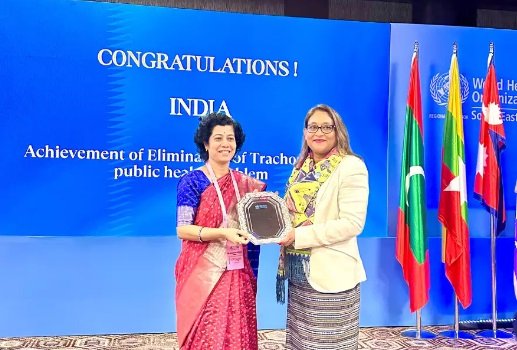The World Health Organization (WHO) recently commended India for its remarkable achievement in eliminating trachoma as a public health problem. With this accomplishment, India joins Nepal and Myanmar as the third country in the WHO Southeast Asia Region to achieve this significant milestone.
The Significance of the Achievement
This recognition by the WHO underscores India’s dedicated efforts to enhance eye health and prevent diseases through its robust healthcare programs. Trachoma, once a leading cause of blindness globally, has now been successfully controlled in India. This victory reflects the country’s progress in improving public health and hygiene standards.
Understanding Trachoma
Trachoma is a bacterial infection that affects the inner lining of the eyelids, leading to painful inflammation and, if left untreated, blindness. The disease thrives in areas with poor hygiene and unsanitary living conditions. In the 1950s and 60s, trachoma was a major public health challenge in India, contributing significantly to the country’s blindness rates.
Government Initiatives to Combat Trachoma
India launched its National Trachoma Control Program in 1963, laying the foundation for the country’s fight against this debilitating disease. Over time, the program merged with the broader National Programme for Control of Blindness, further strengthening efforts to reduce trachoma-related blindness.
As a result of these concerted efforts, the percentage of blindness due to trachoma fell dramatically—from 5% in 1971 to less than 1% today. This significant reduction showcases India’s success in implementing effective public health measures and improving access to healthcare.
WHO’s SAFE Strategy: The Key to Success
India’s fight against trachoma was guided by the WHO’s SAFE strategy, a comprehensive approach designed to combat the disease at multiple levels. The acronym SAFE stands for:
- Surgery to correct eyelid deformities caused by trachoma.
- Antibiotics to treat active infections and prevent further spread.
- Facial cleanliness to reduce transmission of the disease.
- Environmental hygiene to improve living conditions and reduce the factors that contribute to the disease.
By employing this strategy, India was able to eliminate infective trachoma by 2017, a critical step in its journey toward eradicating the disease entirely.
Ongoing Surveillance and Research
Despite this success, India remains vigilant to ensure that trachoma does not resurface. Since 2019, the government has implemented ongoing surveillance measures, including the National Trachomatous Trichiasis Survey (2021-2024). This survey monitors the prevalence of trachoma and ensures that the disease remains under control across the country.
Health Outcomes and Future Impact
India’s efforts to eliminate trachoma have led to impressive health outcomes. In 2021 alone, more than 69,000 individuals received surgical treatment for trachoma-related complications, while around 64.6 million people were treated with antibiotics to prevent the disease from spreading. These measures have drastically reduced the number of people affected by trachoma, improving the overall quality of life and health across the country.
The elimination of trachoma in India represents a critical victory in the global fight against preventable blindness. Through sustained efforts and continued vigilance, India is leading the way in improving eye health and ensuring a brighter future for its citizens.


